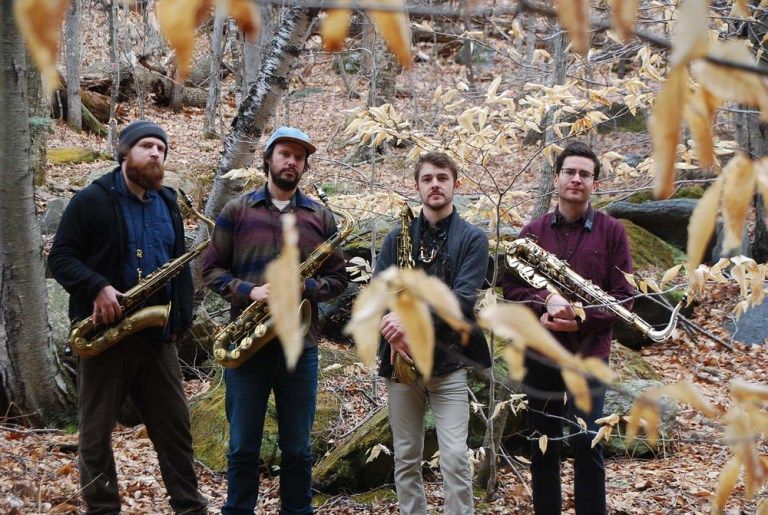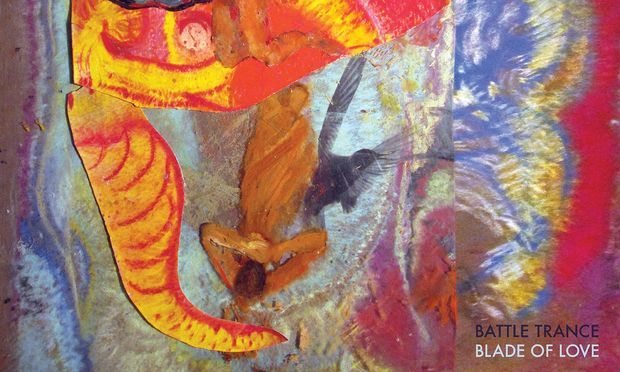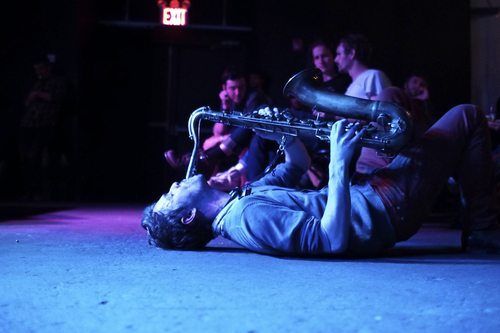Ditmas Park’s Patrick Breiner — Bringing Light & Love To The World Through Music


“When Travis LaPlante invited you to be in a quartet with three other saxophones,” I asked Ditmas Park saxophonist Patrick Breiner, “what was your first thought?”
“Yes,” said Breiner, simply. “ I had no expectations of what it would sound like or where it would go but I figured if Travis was in the front of it, it was worth doing.”
The quartet may be the most enduring line-up in musical history, from countless chamber music string ensembles, through the John Coltrane group that recorded A Love Supreme, to the Fab Four from Liverpool. But Travis LaPlante had something different in mind when he recruited three other tenor saxes (Breiner, Matt Nelson and Jeremy Viner) to form Battle Trance.
The group has just released its second record, Blade of Love. The band will debut the album on Thursday at St. Peter’s Church in Chelsea.

Blade of Love is labeled a jazz album probably because all four musicians have established reputations in that genre, and because jazz is a good description these days for music that isn’t obviously something else.
But there are a lot of other places you could start and find an entry into Battle Trance’s music: contemporary classical, and minimalist, and ambient, and even metal each offers a path. Or you could just start wherever you are and let the group take you someplace else.
“One of the first things that Travis said at our first rehearsal,” Breiner recalled, “was: ‘I want to open a portal.’”
The day after Blade of Love was released, I climbed out the window of Breiner’s second-story apartment. Sitting on the roof overlooking Cortelyou Road, we talked about Battle Trance, the new record, and life as a musician in DItmas Park.
LaPlante said it’s painful for him to explain what Blade of Love means “because in a sense it has no meaning–and at the same time, it means everything.”
I can definitely relate to that. What we do is in some ways the least important thing in the world. It’s not as if, when we make mistakes, people die. I’m not a doctor or a pilot. So it’s not really that important.
But in terms of bringing light to people in the world, what else do we have? There are a lot of ways for people to bring light and love, but this is the way I know how to do it. So for me, it feels incredibly urgent.

Whether people are fans of rock or hip-hop or contemporary popular music, there are some common elements that they expect to hear in music. A lot of those things, they are not going to hear in Battle Trance. But somehow, it’s not as challenging as some forms of avant-jazz. The notes to Palace of Wind point out, “there’s no separation between the listener and the sound.” Do you think that ambient nature of the music can help somebody that’s new to it find their way?
Of all the bands that I’ve ever played in, Battle Trance seems to have the most consistently positive effect on listeners. Especially the live performances.There’s something about being at one of these concerts where the sound is actually physically moving you, you are actually vibrating.
I think that’s where the power is. It’s in the raw truth of the sound. That’s the objective of the music. It’s not to seem clever, it’s not to make people want to dance, it’s not to make money. It’s actually, the objective of the group is to create a connection between you and whatever it is you need to connect with.
There’s a technique that’s fundamental to Battle Trance called circular breathing. Can you explain what that is?
it’s a technique that’s used to create the illusion that there’s unending breath to sustain a pitch more or less indefinitely. It creates the illusion that you can inhale and exhale at the same time. Essentially you are using your cheeks like the bag in a bagpipe. So you fill your cheeks up with air and use the muscles in your mouth to push that air out of the bag while you inhale through your nose.
Was it difficult to develop that facility?
I wouldn’t say it’s difficult. It’s unintuitive for sure, When you start doing it, it’s like anything else. Our mouths are not built to do it. It’s like a saxophone; your mouth is not built to play the saxophone. Your mouth is built to eat.
You’re training your mouth and the muscles of your mouth to produce sound. When you’re learning to play the saxophone, you’re training your lips and your tongue and your throat to shape the air and to create the embouchure on the mouthpiece. [Circular breathing] is the same thing, training your muscles to do something.
How long are you sustaining a note?
I honestly don’t know. It depends on the night. A lot of it depends on the actual performance. We don’t really think about it. There are sections where we’re all meant to be sustaining. But physically, some performances you can get through maybe an 8 or 10 minute section without stopping to take a breath, and then some nights, for whatever reason, somebody needs to take a breath in the middle. The thing about this particular group is that to the audience, if somebody stops to take a breath, you’re actually not going to hear it.

Because much of the music can’t be captured by standard notation, the notes for Palace of Wind say that “the rehearsals were much like martial arts training: intricate sounds were rigorously copied and repeated by the ensemble.” Is that how it felt to you?
I’ve never trained as a martial artist! But it is very physical, it is visceral, and a lot of the stuff that Travis brings us, we can’t do right away.
There’s some multiphonics that he brought in about two years ago, when we started working on the piece, that it took me six months to even get these things to sound.
Travis and I play quite different saxophones. Mine is made in the U.S., his is made in France. If you look at them, they look different. Mine is kind of like an old Chevy; his is more like a Porsche. And I was like, “Maybe it’s my saxophone. I don’t know, it’s just maybe the shape, the tone holes are a little different, whatever.” So, he put his mouthpiece on, and of course it popped right out, on my horn.
So it’s really like his language, he brings it in. We learn it. So in that sense maybe it is a bit like a master bringing in techniques to teach —
Like you are “Grasshopper”?
Yeah. It is very much based on his whole history, his relationship with music. It’s incredibly rigorous, often frustrating, usually hilarious. Everything starts out sounding really bad. That’s usually the thing. I think 90 percent of the stuff we try, it’s like, “That does not sound good. I can see where it’s going. Let’s work with it.”
How long have you lived in Ditmas Park? How did you end up here?

I first started coming here around 2006 or so. I played gigs at Vox Pop when that was still in the space where Lea is now. I started playing at Sycamore quite a bit. Got to know those guys pretty well. My friends and I had a series there called Radio Zero on Monday nights.
There seem to be a significant number of musicians in the neighborhood, and the number seems to be growing. Do you find that to be true? Does that give you opportunities for collaboration?
Yes and yes.
We’re sitting on the roof here and I just saw my friend Cole (Kamen-Green) walk by, a great trumpet player, multi-instrumentalist, really. He’s in a great band called Cuddle Magic, he and his fiance Kristen live across the street. My friend Zach and his lady Amanda live across the street; he’s a bass player, she’s a singer.
There was a period of about a year where if a rehearsal or a gig wasn’t in my neighborhood, I didn’t want to do it. We had a really fun collaborative band that would get together on–I think Monday mornings?
Jesse Stacken, Jesse’s a great pianist, he lived right up at the corner of Beverley and I think Rugby. So he and Adam Hopkins and Martin Urbach, who all live in Ditmas, and our friend Josh Sinton, who lives in Park Slope, we’d meet up every Monday morning and we’d play for two hours and improvise and talk about music with no real objective beyond doing that.
The fact that there are so many people in this neighborhood that play music and who are like-minded about it, that creates special opportunities where you can get together and take a lot of chances without the added weight of say playing a gig, or the possibility of losing money or burning a relationship with a venue because nobody shows up. Like why do we need to play a gig to make music? The answer is “We don’t.” So it definitely creates opportunities.
If there was a young musician moving into the neighborhood who asked you, “How can I get plugged into all of this?” what advice would you give them?
Go to concerts. Go to a lot of concerts. Introduce yourself. Don’t be discouraged by the fact that people will be friendly and say “OK” and after they see you a half a dozen times, they finally remember you.
It’s just that everybody in New York is working so hard just to stay alive. It’s not that they don’t care about you, it’s that they don’t have time to. So the more they see you, the more they get to know you, they’ll probably check out your music, if you have music, and that’s it. All you need are one or two people kind of on your team and you can start building your spider web of connections from there.
There are some venues for live music in the neighborhood. Qathra is stepping up. Are there other places that might be off the radar for live music that people can check out?
There’s a place on the corner of Fenimore and Flatbush Avenue called Delroy’s. Me and Adam Hopkins and Anaïs Maviel and Jake Henry are running a series there on Monday nights of mostly improvised music but some other stuff as well. We’ve had quite a wide variety of music come through there. It’s always great. It’s a really tiny place, like the size of this right here. So you get 20 people in there and it is packed.
Nice little wine bar. Michael Campbell, who runs the place, is incredibly generous. Every venue in New York expects a lot and they want it right away. We approached him almost two years ago. And we’ve had nights where like five people show up. He’s the only person I’ve ever heard say, “Yeah, I get it. You do a weekly series, sometimes there’s an off night. That’s fine. I get it.”
Battle Trance will play at St. Peter’s Church in Chelsea at 7 PM on Thursday (September 22), part of a tour that will take the group through the Southeast and Midwest. Blade of Love and the band’s debut release, Palace of Wind are available as digital downloads and CD through bandcamp.The new album is also available as a vinyl release from NNA Tapes.



